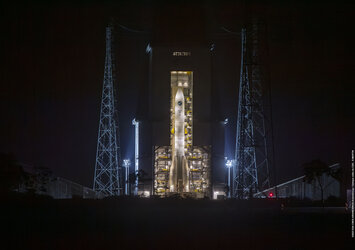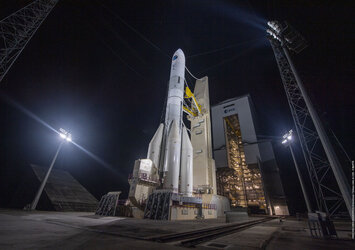

Ariane 6 at dusk
Thank you for liking
You have already liked this page, you can only like it once!
Ariane 6 test model on 24 October 2023 at dusk as the mobile building is rolled away before a test rehearsal. A team of CNES, ESA, Arianespace and ArianeGroup personnel at Europe’s Spaceport in Kourou, French Guiana, completed a full-scale wet rehearsal of the new Ariane 6 rocket that was fuelled and then drained of its fuel. The test lasted over 30 hours with three teams working in shifts of 10 hours each.
The goal was to increase the robustness of the launch system and to test emergency safety procedures with an interruption of the countdown from simulated anomalies.
The wet rehearsal – called combined test loading, abbreviated to CTLO2.1 – is the third time the Ariane 6 ground teams have practiced a full launch countdown, after a first rehearsal on 18 July and a first ignition of the main engine on 5 September. Yesterday’s test concentrated on system robustness and how well Ariane 6 and the teams handle situations at the edge of the operational parameters. This time, the operations were performed at night to test operations in cooler ambient temperatures, while the July and September tests were run in daylight.
Ariane 6 uses liquid oxygen and hydrogen as its fuel to power into space. These power-dense liquids are great fuels but need to be chilled to extreme temperatures below -250°C, making them hazardous to work with. At these temperatures the liquids will instantly expand if it heats up and can cause condensation or even ice on the rocket as it cools down in the surrounding tropically humid air.
Ariane 6 tanks hold 180 tonnes of propellant, which is why fuelling and then draining operations take so long – it took over seven hours to drain the liquid hydrogen from its tanks alone. Engineers are constantly adapting flow rate and monitoring temperatures, pressure in the tanks and pipes, and the ground systems underground pipelines that extend through hundreds of meters to transport the fuel to the rocket.
The core stage of the Ariane 6 now standing on its launchpad is identical to the real thing, but it is not meant to leave Earth. The rocket boosters are inert as they use solid propellant and don’t require fuelling, but the rest is the real deal – including the Vinci upper stage that would only fire its engines once separated from the core stage in space. The fuelling of the upper stage is also included in all rehearsals.
-
CREDIT
ESA/CNES/Arianespace/ArianeGroup/Optique video du CSG-S. Martin -
LICENCE
ESA Standard Licence

Ariane 6 in the spotlights

Ariane 6 during nighttime rehearsal

Ariane 6 on the launchpad for nighttime rehearsal

Ariane 6 before nighttime test

